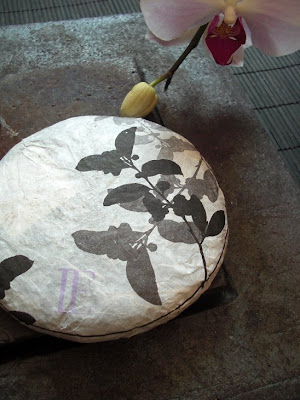
As I mentioned in the previous post, I've been drinking quite a large amount of Chinese teas in the last few days, mainly because of the cloudy cold weather during which my consumption of Japanese green tea naturally shrinks. The weather is already much better around here, being beautifully sunny (though still very cold) and is expected to stay like this in the next few days – but before I return to Japanese teas, there is one more tea which I think deserves attention.
This puerh was purchased on my last visit to the Probuzeny slon teahouse in Brno, Czech republic and comes from Zdenek Prachar's LongFeng.
I'd already talked about LongFeng's private Puerh production at the beginning of summer 2010 – back then, two labels of 2010 collection were available, both made of different spring material.
The collection evolved quite a lot since then, being enriched by two special wedding edition cakes and, most recently, two cakes made of autumnal Maocha – namely the Red and Purple labels.
Both of these are made of wild tree, 300 years old material, which was hand-picked and hand-processed into 200 grams cakes.

The Purple label was processed in November from October-picked Maocha of Lin Cang area; the beeng is quite lightly compressed and is very easy to divide, with single leaves dissolving right as they are separated from the cake.
When poured into the preheated gaiwan, smell of these good-looking leaves fully unfolds – very fruity, sweet, deep and somehow heavy with dominant tones of forest fruits and berries. Compared to most fresh spring puerh teas, this one seems to be more dense and less “wild” and gusty in overall aroma.

The leaves are rinsed before the first infusion is prepared; then after just a short time, this brew is golden yellow in color and maintains the vivid, dense smell of dry leaf. The taste is vividly fruity, reminiscent of forest fruit such as blackberries, raspberries, and bilberries. Though generally quite strong, this taste maintains its smoothness and nobility; it is then followed by long, mouthfilling aftertaste with tones of meadow flowers, young apples and, again, forest fruit.
In terms of color, the second infusion is very similar to its predecessor, being golden yellow and very pure. Its taste is now a bit wilder, yet still very much alike to the previous brews, being strong, fruity and heavy with slight pleasant youthful astringency on tongue. Despite this, the infusion maintains its sweet undertone and produces even longer and vivider aftertaste than the first one.
The third infusion seems a bit lighter yellow in color and smoother in taste, though just as full and complex as all previous brews – the forest fruit tones are a bit less vivid, though still markedly present, as this brew is dominated by somehow fresher tones of flowers and younger, green garden fruit such as apples and pears. Unlike taste itself, the aftertaste is probably the most vivid of all infusions, slightly harsh, astringent and wild, yet still very pleasant and complex.

The fourth, fifth and sixth infusions are very similar to each other, both in terms of color, which is light-yellow and in character, maintaining both the flowery and fresh fruity notes of garden fruit and deeper, denser and sweeter nuances of forest berries. The aftertaste remains quite vivid, though it now is less harsh and somehow smoother, especially in the fifth brew.
Four (or five? I stopped counting) more enjoyable infusions are prepared before the end of this session, gradually lighter in body, less complex and more refreshing and flowery.

This tea will surely be a jewel to drink after some time of aging – I am probably going to consider buying another cake(s) in the near future (before they are all sold out), as I won't help myself in drinking this one while its still fresh – it's that good, already.



























